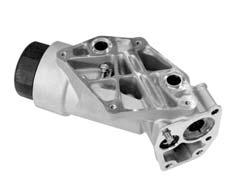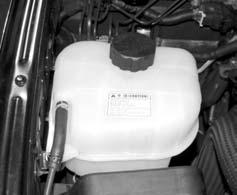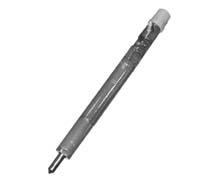CLEANNESS
Cleanness of DI Engine Fuel System and Service Procedures
The fuel system for DI engine consists of transfer (low pressure) line and high pressure line. Its highest pressure reaches over 1600 bar. Some components in injector and HP pump are machined at the micrometer 100 µm of preciseness. The pressure regulation and injector operation are done by electric source from engine ECU. Accordingly, if the internal valve is stucked due to foreign materials, injector remains open. Even in this case, the HP pump still operates to supply high pressurized fuel. This increases the pressure to combustion chamber (over 250 bar) and may cause fatal damage to engine. You can compare the thickness of injector nozzle hole and hair as shown in below figure (left side). The right side figure shows the clearance between internal operating elements.

Valve actuator lift: 0.028 mm
Hair
Diameter: 0.40 mm
Nozzle hole

Operating clearance: 0.002 mm Diameter: 2.0 mm
The core elements of fuel system has very high preciseness that is easily affected by dust or very small foreign material. Therefore, make sure to keep the preliminary works and job procedures in next pages. If not, lots of system problems and claims may arise.
Job procedures
1.Always keep the workshop and lift clean (especially, from dust).
2.Always keep the tools clean (from oil or foreign materials).


3.Wear a clean vinyl apron to prevent the fuzz, dust and foreign materials from getting into fuel system. Wash your hands and do not wear working gloves.
4.Follow the below procedures before starting service works for fuel system.
Carefully listen the symptoms and problems from customer.
Visually check the leaks and vehicle appearance on the wiring harnesses and connectors in engine compartment. Perform the diagnosis proceee with Scan-i (refer to “DIAGNOSIS” section in this manual).

Locate the fault. If the cause is from fuel system (from priming pump to injector, including return line), follow the step 1 through step 3 above.
5.If the problem is from HP pump, fuel supply line or injector, prepare the clean special tools and sealing caps to perform the diagnosis for DI engine fuel system in “DIAGNOSIS” section in this manual. At this point, thoroughly clean the related area in engine compartment.

Notice
Cleantheenginecompartmentbeforestartingserviceworks.
6.Follow the job procedures. If you find a defective component, replace it with new one.


Disconnect the negative battery cable.
For safety reasons: check pressure is low before opening the HP systems (pipes)
Use special tools and torque wrench to perform the correct works.



Plug the disconnected parts with sealing caps, and remove the caps immediately before replacing the components.
Cap position
Once disconnected, the fuel pipes between HP pump and fuel rail and between fuel rail and each injector should be replaced with new ones. The pipes should be tightened to specified tightening torques during installation. Over or under torques out of specified range may cause damages and leaks at connections. Once installed, the pipes have been deformed according to the force during installtion, therefore they are not reusable. The copper washer on injector should be replaced with new one. The injector holder bolt should be tightened to specified tightening torque as well. If not, the injection point may be deviated from correct position, and it may cause engine disorder. Supply line Return line
Priming pump

7.Plug the removed components with clean and undamaged sealing caps and store it into the box to keep the conditions when it was installed.
8.Clear the high pressure offset value by Scan-100 after replacing the high pressure pump.

Warning
Do not crank engine before having filled pump.
9.To supply the fuel to transfer line of HP pump press the priming pump until it becomes hard. 10.Check the installed components again and connect the negative battery cable. Start the engine and check the operating status. 11.With Scan-i, check if there are current faults and erase the history faults.
Note
DI Engine and Its Expected Problems and Remedies Can be Caused by Water in Fuel
SYSTEM SUPPLEMENT AGAINST PARAFFIN SEPARATION.
In case of Diesel fuel, paraffin, one of the elements, can be separated from fuel during winter and then can stick on the fuel filter blocking fuel flow and causing difficult starting finally. Oil companies supply summer fuel and winter fuel by differentiating mixing ratio of kerosene and other elements by region and season. However, above phenomenon can be happened if stations have poor facilities or sell improper fuel for the season.
In case of DI engine, purity of fuel is very important factor to keep internal preciseness of HP pump and injector. Accordingly, more dense mesh than conventional fuel filter is used. To prevent fuel filter internal clogging due to paraffin separation, SYMC is using fuel line that high pressure and temperature fuel injected by injector returns through fuel filter to have an effect of built-in heater (see fuel system).
SYSTEM SUPPLEMENT AND REMEDY AGAINST WATER IN FUEL
As mentioned above, some gas stations supply fuel with excessive than specified water. In the conventional IDI engine, excessive water in the fuel only causes dropping engine power or engine hunting. However, fuel system in the DI engine consists of precise components so water in the fuel can cause malfunctions of HP pump due to poor lubrication of pump caused by poor coating film during high speed pumping and bacterization (under long period parking).
To prevent problems can be caused by excessive water in fuel, water separator is installed inside of fuel filter. When fuel is passing filter, water that has relatively bigger specific gravity is accumulated on the bottom of the filter.
If water in the separator on the fuel filter exceeds a certain level, it will be supplied to HP pump with fuel, so the engine ECU turns on warning light ( ) on the meter cluster and buzzer if water level is higher than a certain level. Due to engine layout, a customer cannot easily drain water from fuel filter directly, so if a customer checks in to change engine oil, be sure to perform water drain from fuel filter. (See fuel system for details.)

STRUCTURE
Front view
Rear view


Left side view

Right side view

























INTAKE AIR FLOW CHART
Intake valve (in combustion chamber)
Air cleaner side Engine
Turbocharger (compressor)
Intake manifold
HFM sensor
Intake hose (outlet) Intercooler
Intake hose (inner)








EXHAUST AIR FLOW CHART
Catalytic converter
Exhaust pipe
Muffler
Turbocharger (turbine side)
Exhaust gas
Turbocharger booster
Exhaust manifold
EGR pipe
Ambient air
EGR vacuum modulator To turbocharger booster Turbocharger booster vacuum modulator
EGR valve














COOLANT FLOW CHART
Heater
Oil cooler
Coolant reservoir
Intake manifold
Thermostat
Water pump
Coolant outlet port Outlet hose
Cooling fan
Radiator








FUEL SUPPLY SYSTEM
High pressure pump
IMV valve
Low and high pressure pump
Fuel temperature sensor
Water separator
Fuel filter
Water detection sensor
Prining pump
Fuel tank
Components:
- High pressure fuel pump


- Fuel injectors

Injector Sensors

HFM sensor Cam position sensor Crank position sensor Knock sensor etc. ECU
Fuel pressure sensor
Common rail
High pressure pipe
Label (C21)
- Fuel rails - Electroc control unit (ECU)
Supply line
- Various sensors and actuators Return line ECU communication line


- Fuel pressure sensor
According to input signals from various sensors, engine ECU calculates driver’s demand (position of the accelerator pedal) and then controls overall operating performance of engine and vehicle on that time. ECU receives signals from sensors via data line and then performs effective engine air-fuel ratio controls based on those signals. Engine speed is measured by crankshaft speed (position) sensor and camshaft speed (position) sensor determines injection order and ECU detects driver’s pedal position (driver’s demand) through electrical signal that is generated by variable resistance changes in accelerator pedal sensor. Air flow (hot film) sensor detects intake air volume and sends the signals to ECU. Especially, the engine ECU controls the air-fuel ratio by recognizing instant air volume changes from air flow sensor to decrease the emissions (EGR valve control). Furthermore, ECU uses signals from coolant temperature sensor and air temperature sensor, booster pressure sensor and barometric sensor as compensation signal to respond to injection starting, pilot injection set values, various operations and variables.




Specifications
Systems Items Diesel Remark
GeneralOverall length (mm)
Overall width (mm)
Overall height (mm)
Gross vehicle weight (kg) Curb weight (kg) Min. turning radius (m) Ground clearance (mm)
Engine Manual transmission Automatic transmission
Fuel Fuel tank capacity Model No. of cyl./Compression ratio
Total displacement Camshaft arrangement
Max. power Max. torque Injection timing Idle speed Cooling system Coolant capacity Lubrication Max. oil capacity Turbo charger and cooling type Type
Model Type
4,720 (4,785) 1,870 1,760 (1,830)
AT: 2450 (2510), MT: 2405 (2465) AT: 1995 (2055), MT: 1950 (2010) 5.6 200 Diesel 80 D27DT 5/18:1 2,696 cc DOHC 170 ps/4,000 rpm 34.7 kg•m/1,800 rpm ATDC 4° ± 1°(at idle) 760 ± 50 rpm
Water-cooled/forced circulation Approx. 11.5 Gear pump, forced circulation 9.3
( ):optional item
IDI Engine4.007 2.367 1.473 1.000 0.872 3.700
Turbo charger, air-cooled Remote control, floor change type 1st 2nd 3rd 4th 5th Rev. 1st 2nd 3rd 4th 5th Rev. 1st Rev. 2nd
2.742 1.508 1.000 0.7082.429 -
DI Engine4.315 2.475 1.536 1.000 0.807 3.591 Electronic Floor change type 2.742 1.508 1.000 0.7082.429 -
3.595 2.186 1.405 1.000 0.831 3.162 1.926
Specifications (Cont’d)
Systems
Transfercase
Items
Diesel
Remark
Clutch Power steering
Front axle
Rear axle Brake
Suspension
Air conditioner
Electrical
Gear ratio
Steering angle
Type
Model Type Type Disc type Type Drive shaft type Axle housing type Drive shaft type Axle housing type Master cylinder type Booster type Parking brake Front Rear Refrigerant Compressor type
High Low Inner Outer Inner Outer
Battery type/Capacity (V-AH) Starter capacity (V-kW) Alternator capacity (V-A)
Part-time
Planetary gear type 1.000 : 1 2.483 : 1
Hydraulic [A/T: Torque converter]
Dry single diaphragm type [A/T: 3 elements 1 stage 2 phases] Rack and pinion 36° 17 ' 32° 40 '
Ball joint type Build-up type Semi-floating type Build-up type Tandem type Vacuum booster Disc Drum (Disc)
Cable type (internal expansion) Wishbone + Coil spring 5-link + Coil spring R134a
Vane type MF / 12 - 90
IDI DI Gasoline
Diesel : 12 - 2.2, Gasoline : 12 - 1.8 12 - 75 (12 - 90) 12 - 140 (12 - 115) 12 - 115
( ):optional item
MAINTENANCE
Major Components and Service Interval
* Use only Ssangyong Genuine Parts. Components
Engine oil and oil filter
Gasoline engine
DI diesel engine
IDI diesel engine
Coolant
Brake pipe and hose
Brake pad, shoe and disc
Air cleaner element
Daily Weekly OOOO--
Gasoline engine
DI diesel engine
Fuel filter
IDI diesel engine Gasoline engine DI diesel engine IDI diesel engine
Automatic transmission oil
4-speed 5-speed
Manual transmission oil
Transfer case oil
Axle oil
Air conditioner air filter
Spark plug (gasoline engine)
-O -O -O -------
Service Interval Remarks
Initial change: 10,000 km
Replace at every 15,000 km
Initial change: 5,000 km
Replace at every 10,000 km or 12 months
More frequent maintenance is required if the vehicle is operated under severe condition.
Severe conditions?
-Frequent low-speed operation as in stop-and-go traffic
-When most trips are less than 6 km (in winter, less than 16 km)
-Driving in sandy, dusty, and salty road
-Driving in mountainous areas
-Extensive idling or high load operation such as towing a trailer
Replace at every 60,000 km or 3 years
Initial inspection: 1,000 km
Inspect at every 20,000 km, replace if necessary Inspect at every 10,000 km, check or adjust if necessary
Clean at every 15,000 km, Replace at every 60,000 km
Initial clean: 5,000 km, Clean at every 10,000 km, replace if necessary, Replace at every 30,000 km Replace at every 60,000 km
If vehicle is operated under dusty or sandy area, frequently clean and inspect the air cleaner system. If necessary, replace the air cleaner element.
Replace at every 30,000 km (Drain the water from fuel filter at every 10,000 km)
Replace at every 40,000 km
Inspect at every 30,000 km or 1 year, replace if necessary (replace at every 60,000 km if the vehicle is operated under severe conditions)
Inspect at every 10,000 km, Replace at every 60,000 km
More frequent maintenance is required if the vehicle is operated under severe condition.
- Driving in unpaved road - Towing a trailer
Inspect at every 10,000 km, Replace at every 60,000 km (but, frequently chexk the leaks)
Replace at every 30,000 km
Replace at every 10,000 km
More frequent maintenance is required if the vehicle is operated under severe condition.
-Driving in sandy, dusty, and unpaved road -Excessive operation of air conditioner or heater
Replace at every 60,000 km
